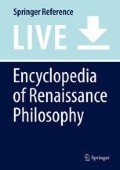Abstract
In order to understand Renaissance astronomy, it is expedient to locate it, as a mixed science, in the cultural system of the time, in particular among the other mathematical disciplines of the quadrivium, and in relation to physical astronomy. Moreover, it is worth considering its internal partitions, beginning with the distinction between theoretical and practical astronomy. In close relation to its university teaching, a canon of sources was established (the so-called corpus astronomicum, together with a corpus astrologicum). During the Renaissance, astronomy underwent momentous transformations, initiated by mathematical humanists such as Georg von Peuerbach and Johannes Regiomontanus. As major steps in the development of the discipline, one shall indicate Copernicus’s work and the heliocentric planetary theory, debates on comets and cosmological space, telescopic astronomy after Galileo, and the physicalization of astronomy after Kepler. Among wider cultural aspects, the criticism of astrology and the socioeconomical factors that supported astronomical studies are here mentioned.
References
On astronomy as a discipline, and its partitions: Christophori Clavii Bambergensis In Sphaeram Iohannis de Sacro Bosco commentarius (Romae: ex officina Dominici Basae, 1581), Praefatio, pp. 1-5; Olaf Pedersen, “The Corpus Astronomicum and the Traditions of Medieval Latin Astronomy,” Studia Copernicana 3 (1975), pp. 57-96; Monica Azzolini, The Duke and the Stars: Astrology and Politics in Renaissance Milan (Cambridge, Mass., UP, 2013), Chap. 1, “The Science of the Stars.”
On Humanistic astronomy, see Michael H. Shank, “Regiomontanus on Ptolemy, Physical Orbs, and Astronomical Fictionalism: Goldsteinian Themes in the Defense of Theon against George of Trebizon.” On the lasting influence of Regiomontanus on Copernican astronomy, see Noel M. Swerdlow, “The Derivation and First Draft of Copernicus’s Planetary Theory: A Translation of the Commentariolus with Commentary,” Proceedings of the American Philosophical Society 117/6 (1973): pp. 423-512.
On Copernicus’s mathematical work, cf. Noel M. Swerdlow and Otto Neugebauer, Mathematical Astronomy in Copernicus’s ‘De revolutionibus’ (New York-Berlin: Springer, 1984). On the reception of Copernicus, see Pietro Daniel Omodeo, Copernicus in the Cultural Debates of the Renaissance: Reception, Legacy, Transformation (Leiden: Brill, 2014).
For the cometary debates of the Renaissance and their impact on conceptions of space and heavenly matter, see Miguel Á. Granada, Sfere solide e cielo fluido: Momenti del dibattito cosmologico nella seconda metà del Cinquecento (Milano: Guerini, 2002), id. (ed.), Novas y cometas entre 1572 y 1618: Revolución cosmológica y renovación política y religiosa (Barcelona: UP, 2012) and Dario Tessicini, and Patrick Boner, Celestial Novelties on the Eve of the Scientific Revolution, 1540-1630 (Firenze: Olschki, 2013). On cosmological infinity, Bruno and Descartes, see Jean Seidengart, Dieu, l’univers et la sphère infinie: penser l'infinité cosmique à l'aube de la science classique (Paris: A. Michel, 2006), Paul-Henri Michel, La Cosmologie de Giordano Bruno (Paris: Hermann, 1962) and Eric John Aiton, The vortex theory of planetary motions (London: MacDonald, 1972).
On Brahe’s project and scholarly network, see: John Robert Christianson, On Tycho’s Island: Tycho Brahe and His Assistants, 1570-1601 (Cambridge: UP, 2000), and Adam Mosley, Bearing the Heavens: Tycho Brahe and the Astronomical Community of the Late Sixteenth Century (Cambridge: UP, 1993). On telescopic astronomy, see: Massimo Bucciantini, Michele Camerota, and Franco Giudice, Il telescopio di Galileo: Una storia europea (Torino: Einaudi, 2012), Albert Van Helden, “Telescopes and Authority from Galileo to Cassini,” Osiris 9 (1994): 8-29, and id. On Sunspots (Chicago: UP, 2010).
On the problem of celestial motions after the dissolution of the celestial spheres, and Kepler’s physicalization of astronomy, see: Bruce Stephenson, Kepler’s Physical Astronomy (New York: Springer, 1987), James R. Voelkel, The Composition of Kepler’s “Astronomia Nova” (Princeton: UP, 2001), and Miguel Ángel Granada, “‘A quo moventur planetae? Kepler et la question de l’agent du mouvement planétaire après la disparition des orbes solides,” Galilaeana 7 (2010): 111-141.
The impact of Pico’s criticism of astrology has been stressed by Robert S. Westman, The Copernican Question: Prognostication, Skepticism, and Celestial Order (Berkeley-Los Angeles-London, 2011), pp. 29-47. On Melanchthon’s support for astrology, see Sachiko Kusukawa, The Transformation of Natural Philosophy: The Case of Philip Melanchthon (Cambridge-New York: Cambridge UP, 1995). On the marginalisation of astrology, see Rienk Vermij, “The Marginalisation of Astrology among Dutch Astronomers in the First Half of the 17th Century,” History of Science 52/2 (2014): 153–177 .
On the link between astronomy, navigation and cosmography, see: William Graham Lister Randles, Geography, Cartography and Nautical Science in the Renaissance: The Impact of the Great Discoveries (Aldershot: Ashgate, 2000), and Klaus Vogel, “Cosmography,” in The Cambridge History of Science, vol. 3, Early Modern Science, ed. by Karin Park and Lorraine Daston (Cambridge: UP, 2006), 469-96. On astronomy and medicine a penetrant case study is Monica Azzolini, The Duke and the Stars: Astrology and Politics in Renaissance Milan (Cambridge, MA-London: Harvard UP, 2013). On the calendar reform, see George V. Coyne, Michael A. Hoskin, and Olaf Pedersen, Gregorian Reform of the Calendar (Vatican: Specola vaticana, 1983). On confessional aspects of astronomical developments during the Renaissance a useful source is Rienk Vermij, The Calvinist Copernicans: The Reception of the New Astronomy in the Dutch Republic, 1575-1750 (Amsterdam: Koninklijke Nederlandse Akademie van Wetenschappen, 2002). On Jesuit and reformed scientific education, enlightening case studies are: Antonella Romano, La contre-réforme mathématique: Constitution et diffusion d’une culure mathématique jésuite à la Renaissance (Rome: École Française de Rome, 1999) and Barbara Bauer (ed.), Melanchthon und die Marburger Professoren (1527-1627) (Marburg: Universitätsbibliothek, 1999).
Author information
Authors and Affiliations
Corresponding author
Editor information
Editors and Affiliations
Rights and permissions
Copyright information
© 2015 Springer International Publishing Switzerland
About this entry
Cite this entry
Omodeo, P.D. (2015). Astronomy. In: Sgarbi, M. (eds) Encyclopedia of Renaissance Philosophy. Springer, Cham. https://doi.org/10.1007/978-3-319-02848-4_251-1
Download citation
DOI: https://doi.org/10.1007/978-3-319-02848-4_251-1
Received:
Accepted:
Published:
Publisher Name: Springer, Cham
Online ISBN: 978-3-319-02848-4
eBook Packages: Springer Reference Religion and PhilosophyReference Module Humanities and Social SciencesReference Module Humanities

